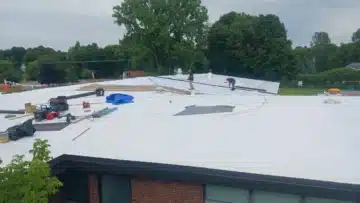Are you worried about the condition of your roof after a storm in Shelburne? Learn how to identify storm damage and protect your home with these simple steps.
Step 1: Visual Inspection
Storm damage to your roof may not always be immediately obvious. Start your inspection by looking for signs of missing or damaged shingles, cracks, or dents. Check for any visible signs of water damage or leaks in your attic, ceilings, or walls.
Inspect the exterior of your roof from the ground using binoculars to look for missing or displaced shingles, granules in your gutters, or any other visible damage. Pay attention to any fallen tree limbs or debris that may have caused harm during the storm.
While assessing your roof’s condition, keep an eye out for signs of wear and tear, such as sagging areas, rust spots on metal roofs, or areas that appear darker than the rest of the roof. These could indicate potential storm damage that needs further investigation.
Remember to document any visible damage with photos or videos for insurance purposes in case you need to file a claim. A thorough visual inspection is the first step in determining if your roof has sustained storm damage.
Step 2: Check for Leaks
Look out for signs of leaks in your home, such as water stains on ceilings or walls, musty odors, or peeling paint. Even small leaks can lead to significant damage over time if left unaddressed.
Inspect your attic for signs of water intrusion, such as damp insulation, mold growth, or water stains. Leaks in the attic can often be a clear indication of roof damage that needs immediate attention.
During heavy rain, observe how water flows off your roof. If you notice any areas where water is pooling or overflowing, it could indicate a problem with your roof’s drainage system. Addressing these issues promptly can prevent further damage.
Step 3: Look for Missing Shingles
Missing shingles are a common sign of storm damage and should be addressed quickly to prevent water infiltration and further roof deterioration. Check for shingles that are cracked, curled, or entirely missing.
Inspect your gutters and downspouts for granules from the shingles, which may indicate damage. Also, look for granules in your yard or driveway as a sign that your roof may be losing its protective layer.
If you find loose or missing shingles, contact a professional roofer to assess the extent of the damage and recommend the necessary repairs. Ignoring missing shingles can lead to more severe issues down the road.
Step 4: Assess Gutters and Downspouts
After a storm, inspect your gutters and downspouts for debris buildup, dents, or damage. Clogged gutters can prevent proper drainage, leading to water pooling on your roof and potential leaks.
Check for any signs of rust or corrosion on metal gutters, as these can weaken the system and affect its functionality. Ensure that downspouts are securely attached and direct water away from your home’s foundation.
Regular maintenance of your gutters and downspouts can help prevent water damage to your roof and foundation. Keeping them clean and in good condition is essential for the overall health of your home’s exterior.
Step 5: Consider Professional Inspection
If you’re unsure about the extent of storm damage to your roof or if you’re unable to safely inspect it yourself, consider hiring a professional roofing contractor for a thorough inspection.
Roofing experts have the knowledge and experience to identify hidden damage and recommend the necessary repairs to restore your roof’s integrity. They can also provide valuable insights on preventative maintenance to keep your roof in top condition.
Professional roof inspections are especially crucial after severe storms to catch any underlying issues before they escalate. Investing in a professional assessment can save you time, money, and hassle in the long run.
Ensuring Roof Safety
Ensuring your roof is free from storm damage is crucial for the safety and integrity of your home. Keep an eye out for the signs mentioned above to address any issues promptly and maintain a secure roof over your head.




